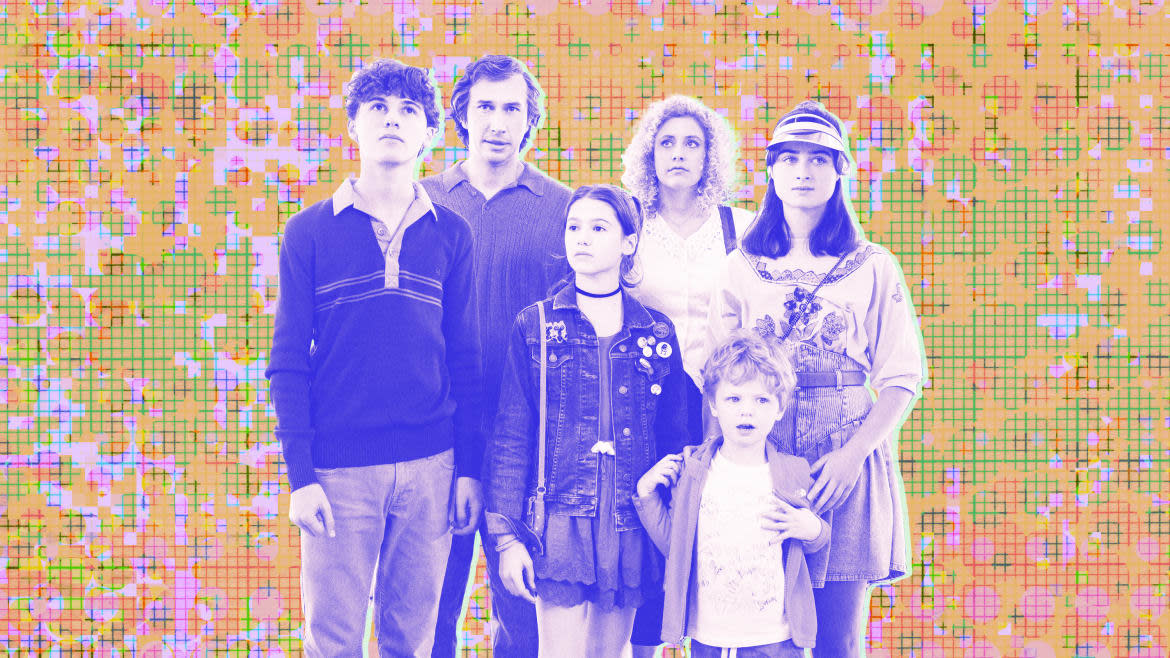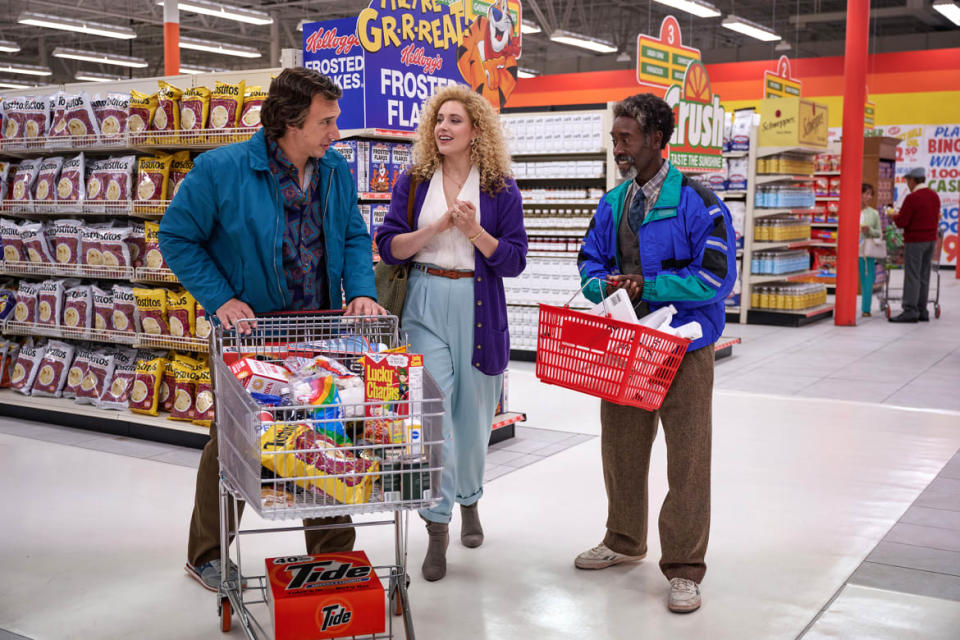‘White Noise’ Has the Most Joyous Dance Sequence of the Season

- Oops!Something went wrong.Please try again later.
- Oops!Something went wrong.Please try again later.
- Oops!Something went wrong.Please try again later.
- Oops!Something went wrong.Please try again later.
- Oops!Something went wrong.Please try again later.
Noah Baumbach’s latest film, an adaption of Don DeLillo’s 1985 apocalyptic novel White Noise, has received mixed reactions from critics since its August premiere at Venice Film Festival. The black comedy, which debuts in select theaters today and on Netflix Dec. 30, is hardly the talky, mundane dramedy you’d expect from the 53-year-old auteur; instead, it’s more of a talky, satirical movie reminiscent of Steven Spielberg’s work. It's a great transitional film from the intense Marriage Story to next year’s live-action Barbie, which Baumbach co-wrote with his partner Greta Gerwig.
Whatever White Noise’s prospects are this awards season, it seems like audiences who’ve screened the movie can agree on one element being particularly great: an end-credits dance number set inside a supermarket.
‘White Noise’ Is One Dark, Messy Satire of America
Those familiar with DeLillo’s novel know that the story ends with an attempted murder. Protagonist Jack Gladney (Adam Driver) discovers his wife Babette (Gerwig) has been sleeping with a man called Mr. Gray (Lars Eidinger) in exchange for the mysterious drug Dylar, which is used to treat her extreme fear of death. Everyone involved in the love triangle ends up getting shot.
After the couple is treated at a hospital (and magically manages to escape the law), Jack, Babette, and their four children head to the now-defunct grocery chain A&P, which they visit in the first act of the film. We hear LCD Soundsystem frontman James Murphy’s distorted voice as “New Body Rhumba,” the catchy, electronic dance song he wrote for the film, begins to play. All at once, the customers begin to pass cereal boxes, produce, and other food items to each other in slow, balletic motions, like euphoric zombies.
Over the course of the seven-minute track, patrons glide through the aisles on shopping carts, toss plastic bags in the air like confetti, and do a line dance. Jack’s fellow academics from the college he teaches at, played by Don Cheadle, André Benjamin (a.k.a. André 3000), and Jodie Turner-Smith, join in on the fun, getting their own brief dance solos. The scene ends with an aerial shot of customers bopping around, as if they’re each listening to the song on AirPods. This final image is instantly reminiscent of the famous scene in A Charlie Brown Christmas, where the characters are each doing their own little jig to “Linus and Lucy.”
In a New York Times interview, Baumbach described the sequence, which was shot over two days at an Ohio supermarket, as “a visual, visceral, physical representation of what I felt like the whole movie was about.” It’s fortunate, then, that the final moment of this otherwise polarizing movie is a marriage of its best components: Murphy’s electric composition, Jess Gonchor’s vibrant production design, and David Neumann’s wonderful choreography.
The Daily Beast spoke to Gonchor and Neumann, who also choreographed scenes in Marriage Story, over Zoom to discuss collaborating with Baumbach, how their contributions impacted one another, and the beauty of Wegmans.

Adam Driver, Greta Gerwig and Don Cheadle in White Noise.
I’ll start with you, David. What was your impression of “New Body Rhumba?” I think it’s such a perfect dance song.
David Neumann: Well, I actually heard it for the first time at the New York Film Festival.
Oh, really?
Neumann: Yeah, we were using other music at the time because the song hadn’t been written. So I went back into LCD’s hit list and found some songs to work with there that would be in the same vibe and have the right sort of tempo or the celebratory feel. “Daft Punk Is Playing At My House” was the one we were using for rehearsals and to shoot it. And it’s kind of a similar tempo.
But “New Body Rhumba” is awesome. The lyrics are amazing. It actually reminds me of Talking Heads.
Speaking of Talking Heads, the choreography calls to mind David Byrne’s American Utopia. Did Noah send you any references or videos?
Neumman: Yeah. I think the main one we looked at at first was from Tout Va Bien, the [Jean-Luc] Godard film. He’s got a scene in a supermarket, which is pretty great. It’s like a dolly shot of these people protesting and going one direction and then the other direction. The cops are beating them up and chasing them out of the supermarket. And we’re just looking at ways in which the supermarket’s represented in film and, in some ways, that time period. But that was about it.
It was mostly going to be a process of discovery, I think. So I did a lot of rehearsing and workshops where I developed some movement. And then I would show [Baumbach] on my iPhone, and he’d go, “Oh, that’s cool.” That’s how we sort of found our way.
I read that you also choreographed the dining room scenes and the big crowd scenes as well. Did you find those to be more or less of a challenge than the dance number?
Neumann: They’re challenging in different ways. I think part of the trick of choreography is, when you’re dealing with some specific kind of vocabulary, you might be working with people with varying degrees of ability to retain the material … so you have to sort of adapt and adjust at all times. It happens in different ways for different kinds of questions and demands in that arena.
But [for] the dance, we had a few groups. We had a core group, a smaller group of six, seven dancers that were from New York, that we developed a lot of the material with. And then we had dancers from Cleveland—movers and dancers, up to about 30 of them. And then there’s a whole bunch of extras who came in the background, people who learned a very simple thing. They didn’t quite learn the full sequence. You can sort of see as the camera pans back to reveal the full supermarket, that there's different kinds of dancing happening.
Going back to the supermarket sequence, were you guys in an abandoned store, or were you able to rent out a Walmart?
Jess Gonchor: We looked around for [existing stores], but nobody would shut down. I think we worked on it for about at least five months and then a month of going in and out filming, so there wasn’t any store that was going to shut down for that long. Wee ended up going into a Target-type of store but not a Target, and we emptied it out completely… We brought in the shelving and created the checkout. It was empty, and we were lucky enough to be able to tailor-fit it for the script.
I think of grocery stores as having this serene, almost heavenly feel, especially with the bright lighting. And in White Noise, it feels like the characters are entering this otherworldly dimension when they visit A&P.
Gonchor: That’s how I felt about it. I wanted it to feel like when my parents dropped me off in upstate New York to a supermarket. There was a supermarket there called Wegmans, and I had never seen one before. Now they’re everywhere, but it was like, wow. It had everything in there. I was used to these little stores, growing up in Brooklyn [and] in Westchester County. And I felt like I wanted the characters and everybody to feel like that… We weren’t leading them down a path or down a hallway with a set. It was just sort of open, and they could discover it for themselves.
With the dance number, it’s like trying to give these guys an environment where they can discover things organically, like they’re really shopping at a store, instead of us saying, “Oh, you need to go over here, pick this up and spin around.” It was this playing ground, and it worked for the movie.
What was the process of obtaining all the food products with the ’80s packaging on them?
Gonchor: You have to remake them. Some things haven’t changed that much, and you can get away with it. I think [the supermarket] was one of the last things we filmed, because it took so long to create. Everybody got to make most of the movie and bring a little bit of that experience to the supermarket, and I think that really helped out with [the dance scene]. But yeah, you have to create or recreate all the labels and get current-period boxes of cereal, and then wrap them with the period packaging and organize them, and maybe fill out the back or some stuff that's not accurate.
I remember going in there before the supermarket had been stocked yet with the ’80s products, and then seeing it on the day it was done. I had that feeling like, “Holy shit!” It was absolutely amazing, the way that the color completely changed the whole space.
How often did each of your work on this film interfere with the other’s?
Neumann: I guess it was all about time. We both needed time in the supermarket, so we tried to figure out how to schedule that, so that Jess could actually stock it. It was a huge, huge job.
Gonchor: I just feel like it’s working together and communicating. There were a number of sets. A lot of this had crossed over into some choreography and art direction, so we both were respectful. We were allowing each other the time that we both needed to make it into something special.
Get the Daily Beast's biggest scoops and scandals delivered right to your inbox. Sign up now.
Stay informed and gain unlimited access to the Daily Beast's unmatched reporting. Subscribe now.

